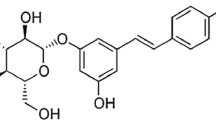Abstract
In this study, the inhibitory effects of selenium-containing heterocyclic compound, selenazol derivatives on LPS-induced nitric oxide production in macrophage cells (RAW 264.7) were assessed. Five kinds of selenazol derivatives were shown to exhibit 5.4∼41.7% of inhibitory effects at 10 μM. Among them, 2-(4-chlorophenyl)-l,3-selenazol-4-one generally evidenced a high degree of inhibitory activity with IC50=11.8 μM, and this compound also profoundly suppressed iNOS expression in LPS-treated RAW 264.7 cells. These results indicated that 2-(4-chlorophenyl)-l,3-selenazol-4-one might function as an anti-inflammatory agent via the inhibition of iNOS-mediated nitric oxide production.
Similar content being viewed by others
Abbreviations
- iNOS:
-
inducible nitric oxide synthase
- LPS:
-
lipopolysaccharide
- L-NMMA:
-
NG-monomethyl-L-arginine
- NO:
-
nitric oxide
References
Bolanos JP, Almeida A, Stewart V, Peuchen S, Land JM, Clark JB, and Heales JR (1997) Nitric oxide-mediated mitochondrial damage in the brain: mechanisms and implications for neurodegenerative diseases. J Neuro-chem 68, 2227–2240.
Cho Y and An B (2008) Anti-inflammatory effect of extracts from cheongmoknosang (Morus alba L.) in lipopolysaccharide-stimulated raw cells. J Korean Soc Appl Biol Chem 51, 44–48.
Kim HJ, Yeom SH, Kim MK, Shim JG, Paek IN, and Lee MW (2005) Nitric oxide and prostaglandin E2 synthesis inhibitory activities of diarylheptanoids from the barks of Alnus japonica steudel. Arch Pharm Res 28, 177–179.
Kim HS, Johnson VJ, Shin TY, and Sharma RP (2004) Selenium attenuates lipopolysaccharide-induced oxidative stress responses through modulation of p38 MAPK and NF-kappaB signaling pathways. Exp Biol Med 229, 203–213.
Kim JM, Son D, Lee P, Lee KJ, Kim H, and Kim SY (2003) Ethyl acetate soluble fraction of cnidium officinale MAKINO inhibits neuronal cell death by reduction of excessive nitric oxide production in lipopolysaccharide-treated rat hippocampal slice cultures and microglia cells. J Pharmacol Sci 92, 74–78.
Kota RS, Rutledge JC, Gohil K, Kumar A, Enelow R, and Ramana C (2006) Regulation of gene expression in RAW 264.7 macrophage cell line by interferon-gamma. Biochem Biophys Res Commun 342, 1137–1146.
Koketsu M, Takenaka Y, and Ishihara H (2001) Preparation of l,3-Selenazol-4-one derivatives from primary selenoa-mides and haloacyl halides. Synthesis 1, 1–4.
Lee S, Min HY, Huh SK, Kim EY, Lee E, Song S, and Kim S (2003) Styrylheterocycles: A novel class of inhibitors on lipopolysaccharide-induced nitric oxide production. Bioorg Med Chem Lett 13, 3689–3692.
Lee SJ and Lim KT (2008) Inhibitory effect of 30-kDa phytoglycoprotein on expression of TNF-α and COX-2 via activation of PKCα and ERK 1/2 in LPS-stimulated RAW 264.7 cells. Mol Cell Biochem 317(1-2), 151–159.
Maniscalco M, Sofia M, and Pelaia G (2007) Nitric oxide in upper airways inflammatory diseases. Inflamm Res 56, 58–69.
Matsuda H, Kageura T, Morikawa T, Toguchida I, Harima S, and Yoshikawa M (2000) Effects of stilbene constituents from Rhubarb on nitric oxide production in lipopolysaccharide-activated macrophages. Bioorg Med Chem Lett 10, 323–327.
Pacher P, Beckman JS, and Liaudet L (2007) Nitric oxide and peroxynitrite in health and disease. Physiol Res 87, 315–424.
Southan GJ, Salzman AL, and Szabo C (1996) Potent inhibition of the inducible isoform of nitric oxide synthase by aminoethylisoselenourea and related compounds. Life Sci 58(14), 1139–1148.
Ueda S, Terauchi H, Suzuki K, Yano A, Matsumoto M, Kubo T, Minato H, Arai Y, Tsuji JI, and Watanabe N (2005) Novel and orally bioavailable inducible nitric oxide synthase inhibitors: synthesis and evaluation of optically active 4,5-dialkyl-2-iminoselenazolidine derivatives. Bioorg Med Chem Lett 15, 1361–1366.
Virgili F, Kobuchi H, and Packer L (1998) Procyanidins extracted from pinus Maritima (Pycnogenol): Scaven-gers of free radical species and modulators of nitrogen monoxide metabolism in activated murine RAW 264.7 macrophages. Free Radic Biol Med 24, 1120–1120.
Yun CH, Yang JS, Kang SS, Yang Y, Cho JH, Son CG, and Han SH (2007) NF-kappaB signaling pathway, not IFN-beta/STAT1, is responsible for the selenium suppression of LPS-induced nitric oxide production. Int Immunopharmacoll, 7 1192–1198.
Author information
Authors and Affiliations
Corresponding authors
Rights and permissions
About this article
Cite this article
Choi, S.Y., Jo, Y.O., Koketsu, M. et al. Inhibitory effects of 2-(4-chlorophenyl)-1,3-selenazol-4-one on lipopolysaccharide-induced nitric oxide production in RAW 264.7 cells. J. Korean Soc. Appl. Biol. Chem. 52, 371–374 (2009). https://doi.org/10.3839/jksabc.2009.066
Received:
Accepted:
Issue Date:
DOI: https://doi.org/10.3839/jksabc.2009.066




